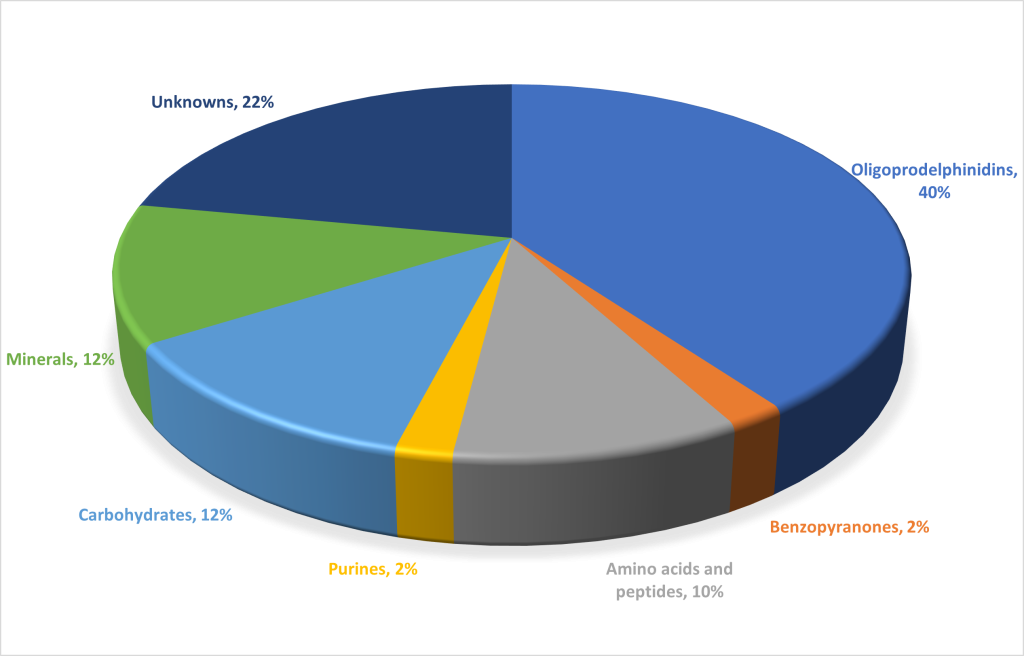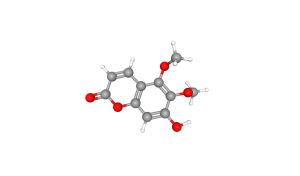Introduction
Pelargonium product is obtained from the dried roots of Pelargonium sidoides DC and/or Pelargonium reniforme Curt by extraction with aqueous ethanol.
The Pelargonium extract contains a large number of compounds derived from both the primary and secondary metabolism of the plant.
Schoetz et al (2008) published a comprehensive profile of Pelargonium extract. The composition of the extract they reported is shown in the pie chart. The predominant group of compounds were the oligoprodelphinidins (proanthocyanidins, flavonoids, tannins) which are likely responsible for some of the reported pharmacological effects of Pelargonium.
Primary plant metabolites (carbohydrates, amino acids/peptides and minerals/inorganic salts) make up the next most prevalent constituents. Purine derivatives including DNA/RNA and cellular signalling chemicals GMP and AMP.
Secondary metabolites the benzopyranones (coumarins) constitute about 2% of Pelargonium. Some of these compounds are also responsible for the pharmacological properties.
Proanthocyanidins
These are a class polyphenolic compounds and belong to a the larger group of flavonoids. They are present flowers, fruit, nuts, seeds and roots of plants including Pelargonium species. These chemicals are responsible for the taste and aroma of these plants. They also have much biological potential including as antioxidants, lipid lowering and anticancer (Rauf et al 2019). In Pelargonium they are one of the constituents responsible for the antimicrobial and immunomodulatory activity (Brendler and van Wyk, 2008).
Coumarins
Coumarins belong to the benzopyrone family and a re present in many plants with medicinal properties. The immunomodulatory activity of Pelargonium is attributed to the coumarins (Brendler and van Wyk, 2008). The coumarins are secondary metabolites of P. sidoides and P. reniforme which are distinctive. The different distribution allows identification of each species. Both species contain scopoletin (7-hydroxy-6-methoxycoumarin) which is also present in the roots of many other plants. P. sidoides contains the trioxygenated coumarin, Umckalin (7-hydroxy-5,6-dimethoxycoumarin) which is not present in P. reniforme. On the other hand, P. reniforme contains fraxinol and isofraxetin which P. sidoides does not. Additionally, P. sidoides contains coumarin sulfates and coumarin glycosides that are not present in P. reniforme (Kolodziej 2007).
Warfarin
Because one well known coumarin derivative, warfarin, is used as an anticoagulant, there is an erroneous assumption that all coumarins have this property. Researchers Karl Link and Harold Cambell synthesised the molecule warfarin, a variant of dicoumarol. It was named warfarin after their funding agency (Wisconsin Alumni Research Fund ) (Yarnell and Abascal, 2009)
References
Brendler T and van Wyk BE. (2008) A historical, scientific and commercial perspective on the medicinal use of Pelargonium sidoides (Geraniaceae). J Ethnopharmacol 119: 420-433.
Kolodziej H. (2007) Fascinating metabolic pools of Pelargonium sidoides and Pelargonium reniforme, traditional and phytomedicinal sources of the herbal medicine Umckaloabo. Phytomedicine 14 Suppl 6: 9-17.
Rauf A, Imran M, Abu-Izneid T, et al. (2019) Proanthocyanidins: A comprehensive review. Biomed Pharmacother 116: 108999.
Schoetz K, Erdelmeier C, Germer S, et al. (2008) A detailed view on the constituents of EPs 7630. Planta Med 74: 667-674.
Yarnell E and Abascal K. (2009) Plant Coumarins: Myths and Realities. Alternative and Complementary Therapies 15: 24-30.

